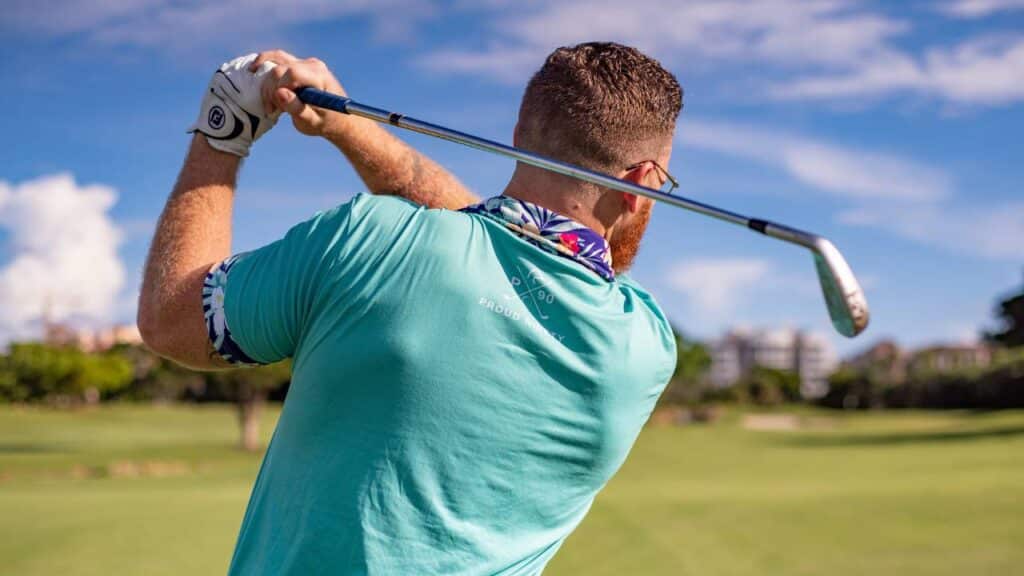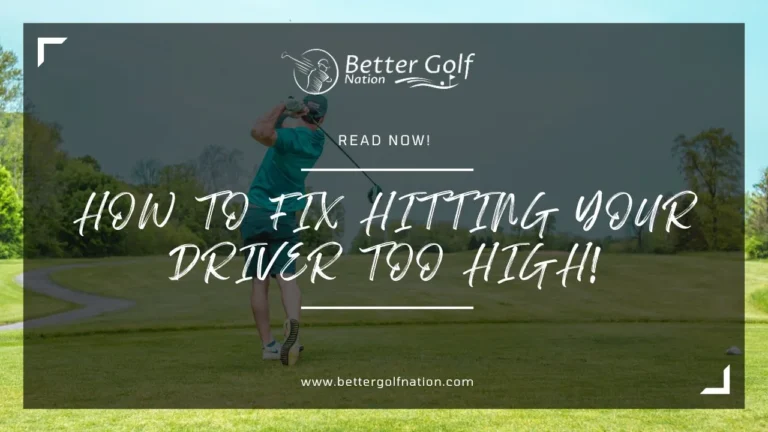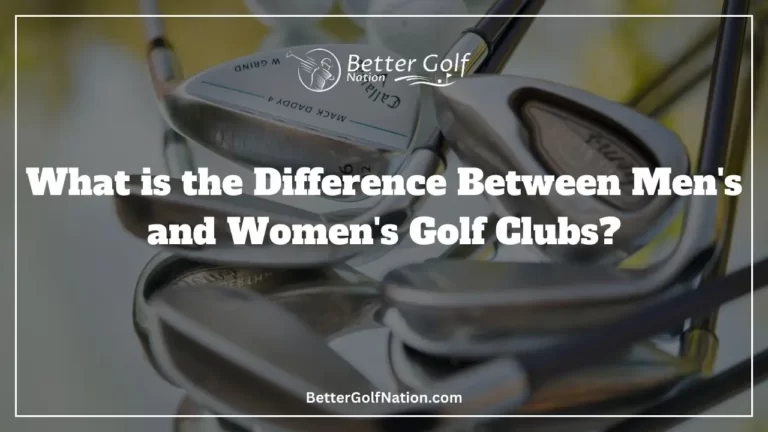Slice vs. Hook: Understanding Golf Shot Differences
- Last updated on August 2, 2023
- Toni Benedito
- Golf Equipment & Gear, Blog
Slice and hook are common issues in golf where the ball deviates from its intended path, curving to the right or left, respectively. These deviations are typically caused by the swing direction and club path. While there’s no universal fix, various techniques can help reduce or eliminate these problems, improving your golf game.

Key Takeaways
- Golfers often face the slice vs. hook problem, with the ball deviating to the right (slice) or left (hook) after being hit with the club.
- Slices are caused by an outside-to-inside swing path, while hooks result from an inside-to-out swing path.
- To improve shots, golfers can adjust grip pressure, stance, and use different clubs. There’s no universal fix, but practice and experimentation can help.
- Identifying slice vs. hook involves analyzing ball flight, trajectory, and where impact occurs on the clubface.
- Techniques to correct slice and hook include adjusting grip, swing path, wrist action, and using drills to improve swing and ball flight. Proper equipment selection is also important.
Introduction
Golf is a game of precision and accuracy, but even seasoned veterans can struggle with the unpredictable nature of their shots. One of the most frustrating issues that golfers face is the slice vs. hook problem. This issue arises when the ball deviates from its intended path, either to the right or left, respectively.
The difference between a slice and a hook can be subtle but crucial to understanding if you want to improve your game. The main difference between a slice and a hook is the direction in which the ball moves after it is hit with the club.
A slice occurs when the ball curves in a sideways direction towards your right (if you’re right-handed), while a hook happens when the ball curves towards your left. But why do these issues happen in the first place?
What causes this deviation? A lot of factors can contribute to these issues, such as swing direction, club path, setup, takeaway, and others.
"One of the most frustrating issues that golfers face is the slice vs. hook problem, arising when the ball deviates from its intended path. Slices are caused by an outside-to-inside swing path, while hooks are caused by an inside-to-out swing path. Adjusting grip pressure, changing stance, or using different clubs are techniques to improve swings."
Most commonly, though, slices are caused by an outside-to-inside swing path, while hooks are caused by an inside-to-out swing path. If you tend to come over the top on your downswing (meaning that you move your club from outside in), then you’re likely to experience more slices than hooks in your golf shots.
While there isn’t just one “fix” for these shot-shaping problems that works universally for everyone, there are certainly some tips and techniques that can help you reduce their frequency or even eliminate them entirely from your gameplay. From adjusting your grip pressure to changing up your stance or using different clubs, there are many techniques that golfers utilize to improve their swings.
So if you’re struggling with slicing or hooking, don’t worry—you’re not alone! And we’ve got plenty of tips and tricks up our sleeve that will help you get back on track and play some good golf shots once again!
Check out this video below from Paul Wilson Golf‘s Youtube channel:
Understanding Golf Terminology: Slice vs Hook
When it comes to golf shots, slice, and hook are terms that you’ll hear a lot. But what exactly do they mean?
Both slice and hook refer to the curve that a golf ball takes during flight. If you’re a beginner or new to the sport, understanding these terms can help you analyze your shots and improve your game.
A slice is a common shot among beginners in golf. It happens when the ball spins off to the right (for right-handed players), which causes it to veer off course and land far from its intended target.
The main cause of a slice is an outside-in swing path where the clubface is open relative to the swing path at impact. On the other hand, a hook occurs when the ball flies straight before curving sharply to the left (for right-handed players).
This happens because of an inside-out swing path, where the clubface is closed relative to the swing path at impact. Understanding these two types of shots would help you analyze your shot patterns, making it easier for you to identify areas for improvement in your game.
Your grip can influence how much curve occurs on each golf shot. A strong grip favors shots that have more draw or hook spin, while a weaker grip may result in less draw or fade spin caused by slicing on some occasions.
"Both slice and hook refer to the curve that a golf ball takes during flight. A slice occurs when the ball spins to the right due to an outside-in swing path, while a hook happens when the ball curves sharply to the left due to an inside-out swing path. Your grip can influence these shots and understanding this can help improve your game."
To fix slices and hooks, different techniques can be used depending on which type of shot is occurring more frequently than usual. For instance, fixing slices might involve working on improving swing paths, while fixing hooks might involve adjusting your grip slightly toward neutral if necessary.
PGA Tour professionals often practice their swings with different ball flights using various clubs so they can better understand their swings’ strengths and weaknesses. By doing this, they are able to work on different aspects of their game depending on their current status with regard to slicing or hooking.
Understanding slice vs. hook is essential for any golfer looking to improve his game, as it helps to analyze shot patterns and identify areas for improvement. With the right fixes, aspiring golfers can prevent slices and hooks from becoming major obstacles in their game.
Enjoying this article? Read more:

The Causes of Slice and Hook
When it comes to slicing vs. hooking, there are a variety of factors that can cause both types of golf shots. In general, a slice occurs when the ball curves hard to the right (for a right-handed player), while a hook curves hard to the left.
One common cause of a slice is an open clubface at impact. This means that the face of the club is pointed too far to the right when it makes contact with the ball.
This can be caused by an incorrect grip or improper alignment of your body toward the target line. When this happens, your swing path is usually correct but your clubface is not, so you end up putting side spin on the ball, which causes it to curve significantly off-line.
Check out this video below from Rick Shiels Golf‘s Youtube channel on 5 simple ways to fix your golf hook:
On the other hand, one common cause of a hook is a closed clubface at impact, which means that it’s pointing too far left at impact with your swing path going from inside to outside (toe swinging in first). This type of shot can also be caused by poor grip and alignment, but instead tends to come from an overactive release through impact, where your hands turn over too much, which closes down your clubface.
Fixing these problems requires learning how to properly grip your golf clubs and align yourself correctly. For slices, you may need to work on keeping your wrists more neutral through impact so that you don’t impart as much side spin on your shots.
A slice in golf, often caused by an open clubface, makes the ball curve to the right, while a hook, usually resulting from a closed clubface, makes it curve left. Poor grip and alignment can cause both. Correcting these requires proper grip training, body alignment, and swing path adjustment. "
For hooks, you may need to work on getting more body rotation into your swing so that you don’t have to rely as heavily on hand action. Another potential cause for both types of shots could be coming over-the-top or outside-in in relation to our target line at contact, giving us a good chance that either a hook or slice would occur during our golf shot.
In these cases, we must focus on improving our swing path by dropping our hands more down than outside in order not to close or open our club head. It’s important to note that golfers of all skill levels can struggle with slice vs. hook, and the fixes for these issues are not always straightforward.
It may take time and practice to identify the root causes of your slice or hook, but with patience and dedication, you can improve your swing and see better results on the course. To get a better idea of what causes slice and hook, you can also watch illustrations or videos online or consult with a golf instructor who can help diagnose any swing problems that may be contributing to your wayward shots.

Identifying Slice and Hook: Signs and Symptoms
One of the most frustrating aspects of golf for many players is their inability to consistently hit straight shots. The two major culprits that cause these errant shots are slice and hook.
Identifying whether you’re slicing or hooking can feel like a daunting challenge, but by paying attention to some key signs and symptoms, you’ll be able to diagnose your problem quickly. The first sign of a slice is when your ball starts out going straight or slightly left (for right-handed golfers) but then suddenly veers off sharply to the right in mid-air.
This happens because the club face is open at impact, which sends the ball spinning sideways with “slice spin”. Slices are usually caused by an outside-to-inside swing path where your club head comes across your body as you strike the ball.
On the other hand, a hook starts out going straight before curving sharply left (for right-handed golfers) in mid-air. This happens when your club face is closed at impact, which sends the ball spinning sideways with “hook spin”. The main cause of hooks is an inside-to-outside swing path where your club head moves away from your body as you hit the ball.
"Recognizing whether you're dealing with a slice or a hook in golf can drastically improve your game. Slices are identified by the ball veering sharply to the right and are caused by an open club face at impact. Hooks, on the other hand, curve sharply left due to a closed club face at impact."
Another way to identify a slice or hook is by looking at where you’re hitting on the face of your club.
If you’re consistently hitting towards the toe of your clubface, this may lead to slices because it causes an open face at impact. Conversely, if you’re constantly finding yourself hitting toward the heel side of the clubface, then this could cause hooks because it causes a closed-face angle.
It’s also helpful to pay attention to how high or low your shots are flying. If you notice that most of your shots are flying low with lots of topspin, this could be due to a slice shot pattern, while excessive backspin on every shot may indicate that they are all hooked balls.
It’s essential to analyze your ball’s flight and trajectory, as this will give you further clues on whether you’re slicing or hooking the ball. A slice shot usually carries a low trajectory with a slight fade, while hooks are characterized by a high trajectory with a sharp draw.
Identifying whether you have a slice or hook problem is the first step to correcting your swing flaws. Remember, recognizing the signs and symptoms described above can help you better understand what causes these issues, which will then allow you to focus on making the necessary adjustments to improve your game.
Check out this video below from Morton Golf Sales‘s Youtube channel:
Techniques to Correct Slice and Hook
When it comes to fixing your slice or hook, there are a number of techniques you can try. One of the most effective is changing your grip.
If you have a slice, try rotating your hands slightly to the right (for right-handed golfers) so that your grip is more “closed.” This will help prevent your club face from being open at impact and causing the ball to curve to the right. On the other hand, if you have a hook, try rotating your hands slightly to the left (again, for right-handed golfers) so that your grip is more “open.” This will help prevent your club face from being closed at impact and causing the ball to curve to the left.
Another technique that can help correct slice and hook is adjusting your stance. If you’re hitting a slice, try aligning yourself more toward the right side of the tee box (for right-handed golfers).
On the other hand, if you’re hitting a hook, try aligning yourself more toward the left side of the tee box. This small adjustment in stance can greatly affect how you swing and where the ball ends up.
The swing path is also an important factor when it comes to fixing slices and hooks. For those with a slice, it’s common for their club path to be “over-the-top“, meaning they come down on top of their swing plane instead of from inside out.
To fix this issue, focus on bringing down your club on a flatter plane and leading with their hands through impact. For those struggling with hooks caused by an underhand swing or taking too steep a divot before making contact with an iron shot, try using drills such as aiming at targets that are meant for an outside-to-inside swing movement like trees or tee markers placed near outside target lines while getting lessons from PGA Tour professionals.
Practicing proper ball position in relation to foot placement can also significantly affect one’s ball flight. Commonly, with a slice, the ball is placed too far forward in the stance, and with a hook, it is too far back.
Make sure to put the ball in an appropriate place for your swing direction and clubface angle. Overall, there is no one-size-fits-all approach to fixing slices and hooks, but experimenting with different techniques can ultimately lead to better shots and lower scores on the course.

Drills to Improve Your Swing and Prevent Slice and Hook
One of the best ways to prevent or fix your slice or hook is by improving your swing. There are several drills you can do on the driving range that will improve your swing and help prevent unwanted ball flight shapes.
First, focus on your grip. A weak grip can cause a slice, while a strong grip can cause a hook. Try practicing with different degrees of each to see which one works best for you. One drill to try is the “Vardon” grip, where you overlap the index finger of your trailing hand with the pinky finger of your lead hand. This is a popular grip among many professional golfers. Next, work on your swing path.
The path of your clubhead determines the shape of your golf shot. If you’re struggling with a slice, try swinging more from the inside out, or imagine that you’re swinging around an imaginary tree trunk behind you.
"Improving your swing is key to fixing slices or hooks in golf. Focusing on your grip, swing path, wrist action, and visualizing your shots can lead to consistency. Practice regularly with drills like the 'Vardon' grip or 'the gate drill' to see improvement in no time."
If you tend to hook the ball too much, try swinging more from the outside in. Another drill that can help improve your swing path is called the “gate drill.” Set up two tees about six inches apart and practice hitting shots through them without touching either tee with your club head.
This will help ensure that you’re swinging straight through impact. If wrist action is causing issues in terms of slicing or hooking, try using a training aid such as a wrist brace or watch during practice rounds only, as it won’t be allowed in tournament play.
Additionally, working on shaping shots can also benefit golfers who struggle with slices and hooks. For example, if you typically hit a big slice off the tee, practice hitting controlled fades instead by aiming slightly left (for right-handed golfers) and focusing on creating more spin for control.
Practice visualizing different shots before hitting them, as this mindset allows players to focus their attention deeply while playing; this helps prepare for changes in conditions and unexpected situations. There are several drills you can do to improve your swing and prevent slices and hooks.
Focusing on your grip, swing path, wrist action, shaping shots, and visualization before hitting the ball will help you hit straighter shots more consistently. Remember that consistency is key in golf, and by practicing these drills regularly, you’ll see improvement in no time!

Equipment Considerations: Can Your Clubs Influence Slice and Hook?
When it comes to golf, your clubs play a crucial role in how well you perform. While many golfers may blame their swings for slicing and hooking the ball, it’s important to consider how your equipment may be contributing to these issues.
In fact, the wrong clubs can increase your chances of slicing or hooking the ball, while the right ones can help you improve your game. One way in which your club selection can influence slice and hook is through the club face angle.
A closed club face means that the face is pointing left of where you’re aiming for impact. This often results in a hook shot as the ball curves to the left of its intended target.
On the other hand, an open club face means that the face is pointing right at where you’re aiming for impact. This often leads to a slice shot as the ball curves to the right of its intended target.
Check out this video below from Rick Shiels Golf‘s Youtube channel on 5 simple ways to fix your golf slice:
Another factor related to equipment that can cause a slice or hook is shaft flex. A shaft with too much flex can result in a closed club face at impact, which leads to hooks, while a shaft with too little flex leads to an open clubface, which causes slices.
To prevent these types of shots from happening frequently, we need to ensure we are using appropriate shafts for our swing type. Moreover, understanding the center of gravity (CG) is also important when selecting clubs as it influences ball flight and spin rate, both factors that can contribute greatly toward slicing and hooking tendencies, particularly off-center hits on the toe or heel side of the clubface.
Lower CG on drivers helps with minimizing side spins and promotes straighter shots by reducing slice and overturn spin rates. Grip size also plays an important role in avoiding slice and hook shots when considering pieces of equipment, as smaller grips encourage wrist action, which increases shot shaping, while larger grips minimize wrist action, therefore creating straighter shots.
Choosing proper clubs does not guarantee straight shots, and it is important to continue improving your swing. However, selecting the right equipment can help you prevent or correct slicing and hooking problems by minimizing the gear-related causes of these issues.

Professional Golfers and Their Battle with Slice and Hook
Many PGA Tour professionals face the battle of slice vs. hook, just like amateur golfers. However, they have the advantage of working with their coaches to fix their swings and improve their game.
One example of a professional golfer who struggled with slicing was Rickie Fowler. In his early career, he had a tendency to hit a big slice and lose the ball to the right.
With the help of his coach, Butch Harmon, he made changes to his swing path and grip that allowed him to improve his accuracy and consistency. Another notable professional golfer who faced the challenge of a hook was Tiger Woods.
In 2010, Woods struggled with a hook that caused him to miss fairways and lose confidence in his game. He worked with Sean Foley, a renowned swing coach, who helped him improve his takeaway and club path in order to eliminate the hook from his game.
It’s not just male PGA Tour professionals who face this challenge; female golfers do too. Lydia Ko is one such golfer who has had her share of struggles with slice vs. hook.
Her coach, David Leadbetter, helped her make changes to her grip and posture that helped her reduce her slices and increase control over her ball flight. Even top-ranked players such as world number one Dustin Johnson continue to work on their swings in order to combat slice or hook tendencies.
Johnson has said in interviews that he still works closely with his coach, Claude Harmon III, on maintaining a consistent swing path in order to avoid slices or hooks. It is clear that even professional golfers struggle with slice vs. hook from time to time.
However, they have excellent resources at their disposal, such as coaches and cutting-edge technology like launch monitors, which allow them to analyze every aspect of their swing in detail, so they can identify problem areas more easily than amateurs can. By making tweaks or even major changes when necessary, these top-class players are able to keep improving their performance on the course year after year.
Conclusion
Slice and hook are two of the most common golf shots that every golfer will encounter.
It is important to remember that, as a golfer, it is not necessarily about completely eliminating these shots from your game. Instead, it is more about minimizing their severity level and ensuring they don’t negatively impact your overall score.
As we’ve discussed throughout this article, there are numerous causes of slice and hook. From grip and club path to swing direction and takeaway position, each golfer’s shot shape may be unique in its own way.
That said, understanding the difference between slice and hook is key to identifying which type of shot you need to correct. We’ve also explored various techniques to correct both slice and hook shots, ranging from simple drills to more complex swing changes.
With persistence and patience, any golfer can improve their skills on the course. It’s worth noting that equipment considerations are also critical in determining whether you’re more likely to hit a slice or a hook shot.
Different club types can influence ball movement due to their design characteristics, such as loft angle or face angle. Professional golfers have struggled with both slice and hook shots throughout their careers.
Even if you’re not playing at the highest levels of competition, it can be reassuring to know that even the world’s best golfers struggle with these common issues. By understanding what causes your slices or hooks (and how they differ), taking steps towards correcting them through practice sessions or professional help if necessary (including drills tailored specifically for correcting certain aspects), and testing out different equipment options until finding something optimal for oneself, anyone can become an accomplished golfer who plays consistently well without worrying too much about hitting errant golf shots!
FAQs
What is the main difference between a slice and a hook in golf?
A slice is the result of an open clubface at impact, which causes the ball to curve severely to the right (for right-handed players). On the other hand, a hook is caused by a closed clubface at impact, which makes the ball curve severely to the left (for right-handed players).
Is it better to have a hook or a slice?
It depends on your individual style and strategy in golf. Generally, neither a slice nor a hook is “better” as both can disrupt your game. The key is managing these shots effectively to improve your golf game.
How severe can slices and hooks be?
The severity level of a slice or hook depends on multiple factors such as swing speed, clubface angle at impact, and swing path. In some cases, slices or hooks may only be slight deviations from your target line, while in other cases they could be extreme curves that end up very far from your intended target.
Can a bad swing setup cause a slice and hook?
Yes, an incorrect swing setup can lead to both a slice and a hook. For example, if you have your feet aligned too far left or right of your target line, it can cause you to hit either a slice or a hook. Similarly, having an open or closed stance can also lead to these shot shapes.
Is your grip causing your slice or hook?
Yes, your grip could be causing your slice or hook. The way you hold your club significantly impacts the ball’s direction, and correcting your grip can help prevent unwanted slices or hooks.
Does too strong of a grip cause a hook or can too big of a grip cause a slice?
Indeed, a too strong grip often leads to hooks, while an oversized grip might cause slices. The right grip is essential to achieve optimal control and swing path in golf.
Is it possible for equipment like clubs and balls to affect my ball movement?
Absolutely. Incorrect equipment can also contribute to slices or hooks. For instance, if you are using clubs that are too long or heavy for you, it could make it harder for you to make solid contact with the ball. The type of ball used can also affect spin rates and thus influence the shot shape.
Can a driver that is too long cause a slice?
Yes, a too long driver can cause a slice. When the driver is longer than ideal, it can be harder to control, leading to off-center hits and resulting in a slice.
What's the best way to fix my slice and hook?
The solution will depend on what’s causing your particular problem, but some things that might help include taking lessons from a golf instructor who can analyze your swing mechanics and help you correct any issues.
How do you fix a hook or slice in golf?
Fixing a hook or slice involves understanding your swing dynamics and making the necessary adjustments. Practice proper grip, clubface alignment, and swing path. Consider golf lessons or video analysis for personalized advice.
Share this Post
Toni Benedito
Keep Reading
Follow Us
Recent Posts

How Do Pro Golfers Get Paid? The Business of Golf
Professional golfers get paid both before and after tournaments. Before a tournament, they receive appearance fees, sometimes exceeding $1 million, to attract top players. After the tournament, earnings depend on their placement, with the PGA

How Much Do Golf Players And Pros Make? You Won’t Believe It!
Professional golfers earn substantial incomes through tournament winnings, sponsorship deals, and endorsements. Top players on the PGA Tour can make millions annually, with significant earnings from prize money and lucrative brand partnerships. For example, Rory

The Shocking Cost: How Much Does It Cost to Fly with Golf Clubs?
Flying with golf clubs can be a hassle, but it’s worth it for avid golfers. Costs vary by airline, ranging from $30 to $150 per way. Southwest Airlines offers a generous policy, allowing one set

Why Do Golfers Tape Their Fingers Before Hitting the Course?
Golfers tape their fingers to prevent injuries from repetitive motions, provide support for existing injuries, and improve grip comfort. It’s a popular technique among amateurs and pros alike, offering a lightweight and effective solution compared

How Much Does a Round of Golf Cost? Are You on Par?
The cost of a round of golf varies widely based on factors like course type, location, and time of play. Public courses typically range from $30-$100 per round, while exclusive ones like Augusta National or

Hidden Fees: How Much Does It Cost To Rent a Golf Cart
Wondering how much it costs to rent a golf cart? Explore factors like location, rental duration, and cart type impacting prices. Daily rates range from $50 to $80, while weekly rentals can vary from $200
Table of Contents







